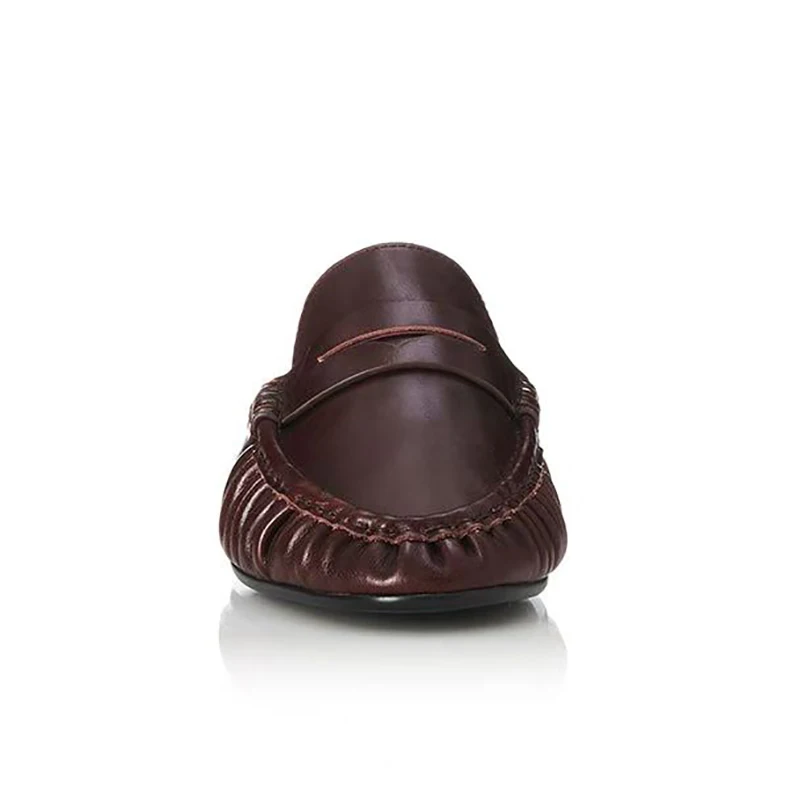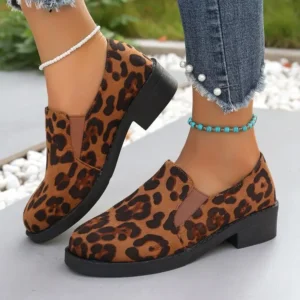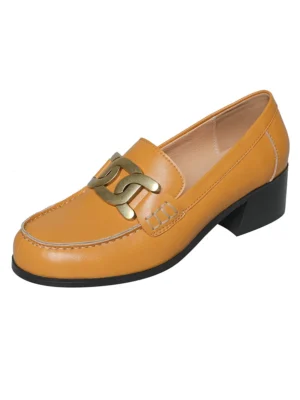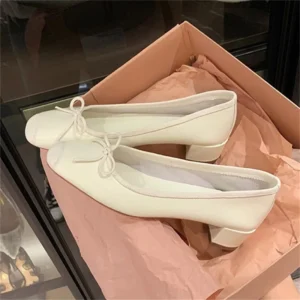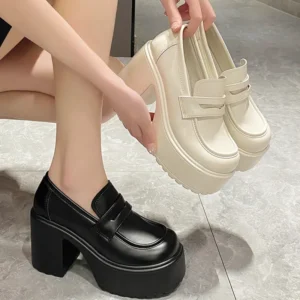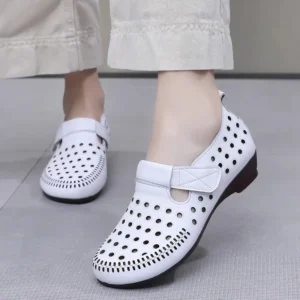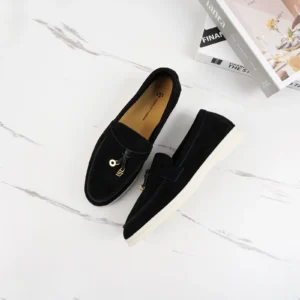Introduction: The Perfect Blend of Elevation and Ease
Finding footwear that successfully balances comfort with style can feel like an endless quest. Many of us have suffered through days of pinched toes and aching arches in the name of fashion, or resigned ourselves to practical but uninspiring options when comfort becomes non-negotiable.
Enter wedge heel loafers – the ingenious hybrid that combines the sleek, sophisticated silhouette of a loafer with the height-enhancing, stable support of a wedge heel. These versatile shoes have gained tremendous popularity among those who refuse to choose between feeling good and looking good. By merging the slip-on convenience of traditional loafers with the elevated stance of a wedge, these shoes offer a unique solution to the age-old comfort-versus-style dilemma.
The rising popularity of wedge heel loafers isn’t surprising when you consider their practical benefits. They provide height without the instability of stilettos, cushioning without the casualness of flats, and versatility that transitions seamlessly across various settings. In this article, we’ll explore exactly why wedge heel loafers have become the go-to choice for those seeking all-day comfort without sacrificing an inch of style. From biomechanical advantages to styling versatility, you’ll discover why these shoes deserve a prime spot in your professional office loafer outfits and everyday wardrobe.
The Biomechanical Advantage: How Wedge Design Supports Your Feet
The science behind wedge heel design reveals why these shoes feel so much better on your feet than traditional heels. The fundamental difference lies in how wedges distribute pressure across your entire foot rather than concentrating it on specific points.
Unlike conventional heels that create a stark angle between the heel and ball of your foot, wedge heels provide continuous support along the entire sole. This uninterrupted contact eliminates the “empty space” found under the arch in traditional heels, offering crucial support to an area often neglected in footwear design. The result is significantly improved stability and reduced strain on the tendons and muscles that work overtime to maintain balance in separated heels.
Wedge designs also dramatically decrease pressure points – those uncomfortable spots where excessive force concentrates, leading to pain and potential injury. In traditional high heels, pressure intensifies dramatically at the ball of the foot and heel, sometimes reaching up to seven times your body weight at the metatarsal heads (the joints at the base of your toes). Wedge designs redistribute this force more evenly.
The biomechanical benefits of wedge heel loafers include:
- More even weight distribution across the entire foot
- Reduced pressure on the ball of the foot and toes
- Enhanced arch support through continuous contact
- Decreased ankle pronation (inward rolling)
- Improved overall stability and balance while walking
Perhaps most importantly, the wedge design promotes a more natural posture than conventional heels. By supporting your foot along its entire length, wedges help maintain proper alignment from your feet through your ankles, knees, hips, and spine. This alignment reduces the risk of back pain that often accompanies long periods in traditional heels, which tend to push the body forward unnaturally.
The foot health benefits of wedge heel loafers extend beyond immediate comfort to potentially preventing long-term foot problems associated with prolonged wear of less supportive footwear. While no elevated shoe can match the natural biomechanics of bare feet, wedge loafers represent a significant improvement over many fashion-forward alternatives.
Superior Weight Distribution: Why Your Feet Feel Less Fatigue
The design genius of wedge heel loafers lies in how they manage the distribution of your body weight. Rather than concentrating pressure on isolated points, wedges spread weight across the entire foot surface, dramatically reducing fatigue even after hours of wear.
When you wear pointed high heels, up to 75% of your body weight can be forced onto the ball of your foot – a relatively small area never designed to bear such concentrated pressure. This leads to the familiar burning sensation many experience after just a short time in conventional heels. Wedge loafers, by contrast, maintain more balanced weight distribution, with pressure shared more evenly between your heel and forefoot. This balance means no single area bears excessive strain, allowing you to stay comfortable significantly longer.
The continuous sole design of wedge loafers also helps prevent metatarsalgia – a painful condition characterized by inflammation in the ball of the foot. By reducing compression of the metatarsal heads (the bones that connect to your toes), wedges help prevent the shooting pain and numbness that often accompany prolonged wearing of traditional heels. This improved weight distribution is particularly beneficial for those who already have sensitive feet or existing foot conditions.
When comparing pressure mapping between different heel types:
- Stilettos: Extreme pressure concentration at ball of foot and heel
- Block heels: Improved heel stability but still significant forefoot pressure
- Wedge heels: Most even distribution pattern with gentle transitions
This superior weight distribution is why many people find they can wear wedge heels that are good for their feet for much longer periods without discomfort. The design works with your body’s natural mechanics rather than against them, resulting in noticeably less fatigue at the end of a long day.
Enhanced Stability: Walk Confidently Without Wobbling
The stability advantage of wedge heel loafers cannot be overstated, especially when compared to other elevated footwear options. Their wider, continuous base provides a substantially larger surface area contacting the ground, creating a more secure foundation with each step.
This expanded base of support directly translates to reduced ankle strain. Traditional narrow heels force your ankle to constantly adjust and balance, engaging stabilizing muscles that quickly fatigue. Wedge designs minimize this lateral wobble, allowing ankle muscles and tendons to maintain a more natural, relaxed position. The result is greater confidence when walking on various surfaces, from smooth office floors to uneven outdoor terrain.
The stability benefits of wedge loafers include:
- Reduced risk of ankle rolls and sprains
- Greater confidence on uneven surfaces
- Less muscular fatigue in stabilizing muscles
- Improved balance when standing for extended periods
- Lower likelihood of tripping or stumbling
For those who value both height and security in their footwear, wedge loafers offer an ideal compromise. You gain elevation without the precarious feeling of balancing on a narrow column. This makes wedge designs particularly valuable for anyone with balance concerns or those who simply prefer feeling firmly planted while maintaining a stylish silhouette.
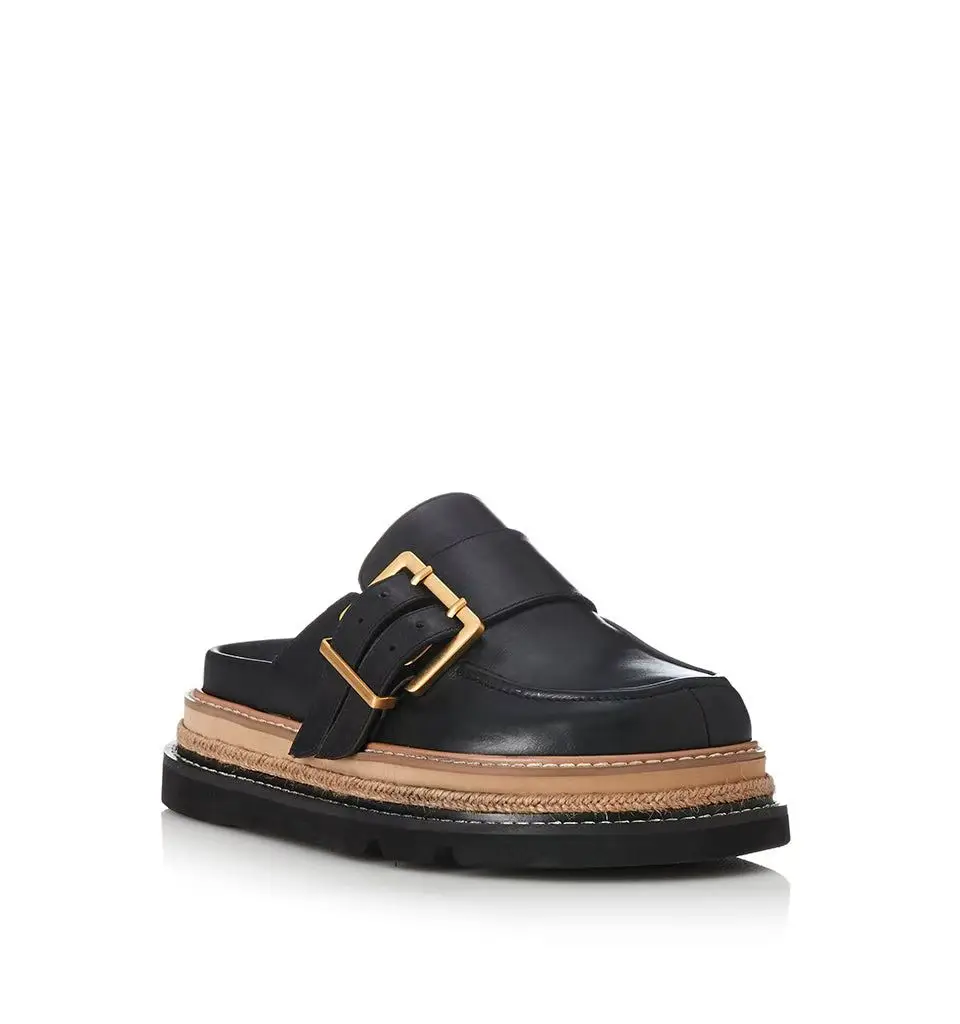
The stability advantage is a key reason why women’s wedge heel loafers have gained such a devoted following. They provide the height enhancement many desire without the instability that often accompanies it, allowing wearers to move through their day with confidence and poise.
The Loafer Advantage: Slip-On Convenience Meets Foot-Friendly Design
The loafer component of wedge heel loafers contributes significantly to their overall comfort profile. Traditional loafers were designed with ease and comfort in mind, and these beneficial features carry over when combined with a wedge heel.
One of the most immediately noticeable loafer advantages is the slip-on design, eliminating the need for straps, laces, or other fastening mechanisms that can create pressure points or restrict foot movement. This smooth, uninterrupted upper allows the foot to sit naturally within the shoe without being squeezed or constrained. Many wedge loafers also feature a wider toe box compared to pointed dress shoes, providing crucial space for toes to maintain their natural position rather than being compressed together.
The typical loafer design also reduces friction points around the ankle and top of the foot. Without straps crossing the instep or ankle, there are fewer opportunities for rubbing, chafing, and blister formation. This becomes especially important during all-day wear, as feet naturally expand slightly throughout the day. The loafer’s more forgiving upper accommodates this normal swelling without becoming uncomfortable.
The synergy between loafer design and wedge heel creates an optimal comfort experience. The loafer portion provides the relaxed, foot-friendly fit, while the wedge delivers stability and height. Together, they address many of the comfort challenges found in other elevated shoes, allowing for natural foot flexion while walking despite the increased height.
For those who appreciate the easy elegance of slip-on styles, our collection of women’s loafer mules offers another variation on this comfort-focused approach to sophisticated footwear.
Materials Matter: Finding the Most Comfortable Options
The materials used in wedge heel loafers play a crucial role in determining their comfort level. Even the most biomechanically sound design can be undermined by poor material choices, while quality materials can enhance an already comfortable shoe.
Upper materials significantly impact both the immediate feel and long-term comfort of wedge loafers. Soft, supple leathers mold to the foot over time, creating a custom-like fit that accommodates your unique foot shape. Premium suedes offer similar benefits with a distinctive textural element. Fabric options can provide more flexibility and breathability, though they may offer less structure and support than leather alternatives.
The interior components of wedge loafers deserve careful consideration, as they directly contact your feet. Cushioned insoles with memory foam or gel inserts can dramatically improve comfort by absorbing impact with each step. Breathable linings help manage moisture and temperature, preventing the discomfort of sweaty feet during extended wear. Some premium wedge loafers even feature padded collars around the opening to prevent rubbing at the heel and ankle.
Outsole materials that enhance comfort include:
- EVA (ethylene vinyl acetate): Lightweight with excellent shock absorption
- Rubber: Durable with good grip and moderate cushioning
- Leather: Classic appearance but less shock absorption
- PU (polyurethane): Balance of flexibility, durability and weight
- Cork: Natural material that molds to foot shape and absorbs shock
The combination of these materials working together determines the overall comfort experience. At Artisan Haul, we carefully evaluate each component when selecting wedge loafers for our collection, ensuring they meet our standards for both immediate comfort and lasting quality.
While wedge loafers focus on a rounded or squared silhouette to maximize comfort, understanding how materials impact different designs can help you make better overall footwear choices. Our guide to pointed toe loafers as a smart choice examines material considerations for that distinct style as well.
All-Day Wearability: From Office to Evening
The true test of any shoe’s comfort comes not from how it feels when first put on, but how your feet feel after wearing it all day. Wedge heel loafers excel in this category, offering remarkable wearability across various environments and activities.
In professional settings, wedge loafers provide the polished elevation expected in business attire without the discomfort that typically accompanies work-appropriate heels. Their stable design allows you to focus on presentations and meetings rather than foot pain, while their sophisticated silhouette maintains a professional appearance. Many professionals find they can comfortably wear wedge loafers throughout an entire workday without the need to keep “emergency flats” under their desk.
The transitional nature of wedge loafers makes them particularly valuable for those with after-work commitments. Unlike other heeled options that become unbearable by day’s end, quality wedge loafers can carry you from morning meetings through evening events without requiring a shoe change. This versatility is especially appreciated during busy days when carrying spare shoes isn’t practical.
For travelers, whether exploring a new city or navigating business trips, wedge loafers offer an ideal blend of comfort and style. They provide enough support for moderate walking while maintaining an elegant appearance suitable for restaurants, museums, or business functions. Their slip-on design also adds convenience when passing through airport security or entering homes where shoes are removed.
Those who stand extensively during their workday – retail employees, teachers, event planners, and others – particularly benefit from the supportive design of wedge loafers. The continuous sole support and even weight distribution help prevent the acute foot fatigue that comes from standing for long periods on hard surfaces.
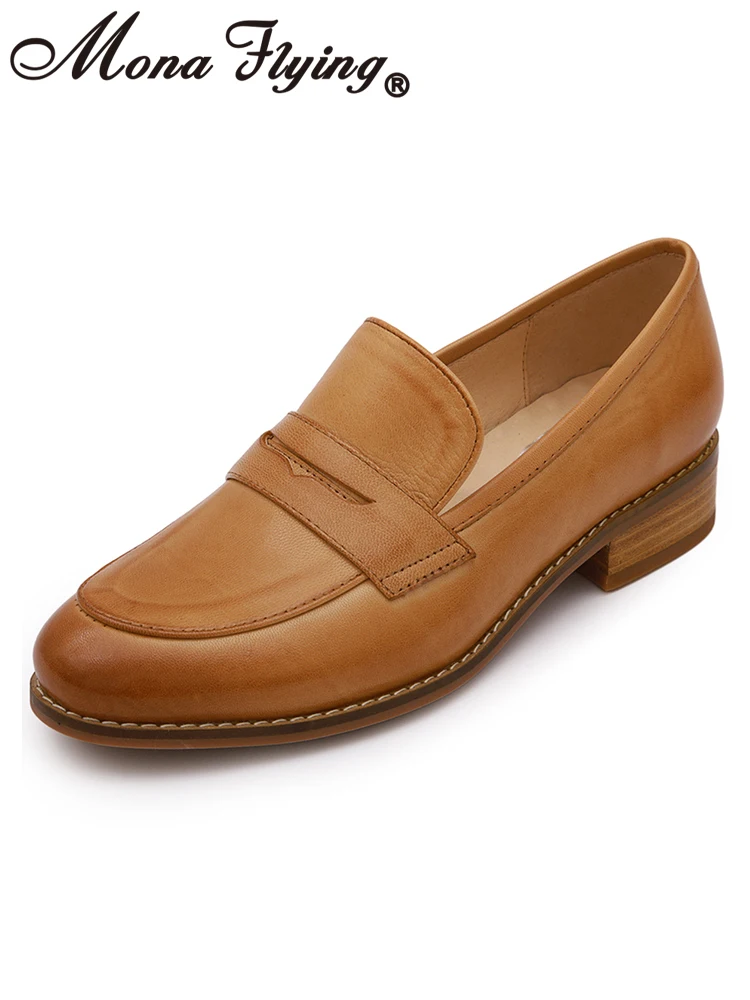
For guidance on incorporating these versatile shoes into your work wardrobe, our guides to wearing loafers at the office and creating business casual loafer outfits provide practical styling advice.
Foot Health Benefits: Beyond Basic Comfort
Wedge heel loafers offer benefits that extend beyond immediate comfort to support overall foot health. While no elevated shoe is as physiologically ideal as properly fitted flat footwear, wedge designs minimize many common issues associated with heeled shoes.
The supportive nature of quality wedge loafers can help reduce the development or aggravation of common foot ailments. By distributing pressure more evenly across the foot, they minimize the excessive force on the forefoot that often contributes to problems like neuromas (thickened nerve tissue between toes) and metatarsalgia (ball of foot pain). The continuous sole also helps prevent the extreme flexion at the ball of the foot that can exacerbate bunion formation.
Arch support varies among wedge loafer styles, but many provide moderate assistance that benefits different foot types. Those with normal arches receive gentle reinforcement that helps maintain proper foot alignment. People with lower arches or mild flat feet often appreciate the full-length contact that supports the midfoot area – a region that collapses without adequate support. Even high-arched feet, which typically need cushioning rather than arch lifting, benefit from the shock-absorbing properties found in quality wedge designs.
Potential foot health benefits of well-designed wedge loafers include:
- Reduced forefoot pressure compared to traditional heels
- More natural gait pattern than steep-angled footwear
- Decreased likelihood of developing black toenails from toe box compression
- Lower risk of ankle injuries due to improved stability
- Better shock absorption than flat-soled dress shoes
While wedge loafers can benefit many foot types, those with specific foot conditions should consult with a podiatrist about appropriate footwear. For those requiring maximum foot support, our collection of comfortable flat loafers provides excellent alternatives when completely flat footwear is preferred.
Women's Comfortable Flat Loafers, Women's Leopard Print Loafers, Women's Low Heel Loafers
$82.50 Select options This product has multiple variants. The options may be chosen on the product pageWomen's Block Heel Loafers, Women's Heeled Penny Loafers, Women's Monk Strap Loafers
$194.04 Select options This product has multiple variants. The options may be chosen on the product pageWomen's Block Heel Loafers, Women's Square Heel Loafers, Women's Square Toe Flat Loafers
Price range: $73.61 through $86.41 Select options This product has multiple variants. The options may be chosen on the product pageWomen's Black Platform Loafers, Women's High Heel Loafers, Women's High Platform Loafers, Women's White Platform Loafers
$106.67 Select options This product has multiple variants. The options may be chosen on the product pageWomen's Comfortable Flat Loafers, Women's Leather Flat Loafers, Women's Round Toe Flat Loafers
$124.88 Select options This product has multiple variants. The options may be chosen on the product pageWomen's Loafer Mules, Women's Suede Flat Loafers
$190.23 Select options This product has multiple variants. The options may be chosen on the product page
Finding Your Perfect Fit: Selection Tips for Maximum Comfort
Even the most thoughtfully designed wedge heel loafer will feel uncomfortable if it doesn’t fit properly. Finding your perfect size and width is essential for experiencing the full comfort potential these shoes can offer.
When trying on wedge loafers, pay special attention to how your foot sits within the shoe. There should be approximately a half-inch of space between your longest toe and the end of the toe box to allow for natural foot expansion throughout the day. The widest part of your foot (the ball) should align with the widest part of the shoe, and you shouldn’t feel pinching at the sides. Remember that feet are rarely perfectly symmetrical, so always fit to your larger foot.
For maximum comfort when selecting wedge heel loafers:
- Shop later in the day when feet are naturally slightly larger
- Wear the type of socks or hosiery you plan to pair with the shoes
- Stand and walk on hard surfaces, not just carpet, during fitting
- Check for heel slippage – a little is normal, excessive sliding isn’t
- Ensure the shoe bends at the same point your foot naturally flexes
- Consider width options if available, as many people need wider shoes than they realize
- Remember that some materials will stretch slightly while others won’t
Most wedge loafers require minimal breaking in compared to stiffer dress shoes, but expect some adjustment period as the shoe molds to your unique foot shape. Walking around your home with them for short periods before wearing them for a full day can help ease this transition and identify any potential problem areas.
For more comprehensive guidance on finding your ideal pair, our guide to finding your sole mate in wedge heel loafers offers additional fitting advice and selection considerations.
Styling Versatility: Comfort Without Fashion Compromise
One of the greatest attributes of wedge heel loafers is their remarkable styling versatility. These shoes effortlessly bridge the gap between casual and formal, allowing you to create cohesive outfits for numerous occasions without sacrificing comfort.
For professional settings, wedge loafers pair beautifully with tailored trousers, pencil skirts, and structured dresses. Their refined silhouette provides the polished elevation expected in business environments, while their comfortable design allows you to project confidence rather than being distracted by discomfort. Dark leather options in classic colors like black, navy, or burgundy create a sophisticated foundation for work-appropriate attire.
In more casual contexts, wedge loafers can transform everyday outfits with an elevated touch. They complement straight-leg jeans, casual skirts, and even shorts during warmer months. Suede versions or those with decorative details like tassels or metal hardware add visual interest to simple outfits. The height they provide creates a leg-lengthening effect that flatters most silhouettes without requiring the balancing act of stilettos.
Season-spanning versatility is another advantage of wedge loafers. They work well from early spring through late fall, pairing easily with or without hosiery depending on the temperature. While extremely hot weather might call for more open styles and snowy conditions require more protective footwear, wedge loafers cover an impressively broad range of seasonal needs.
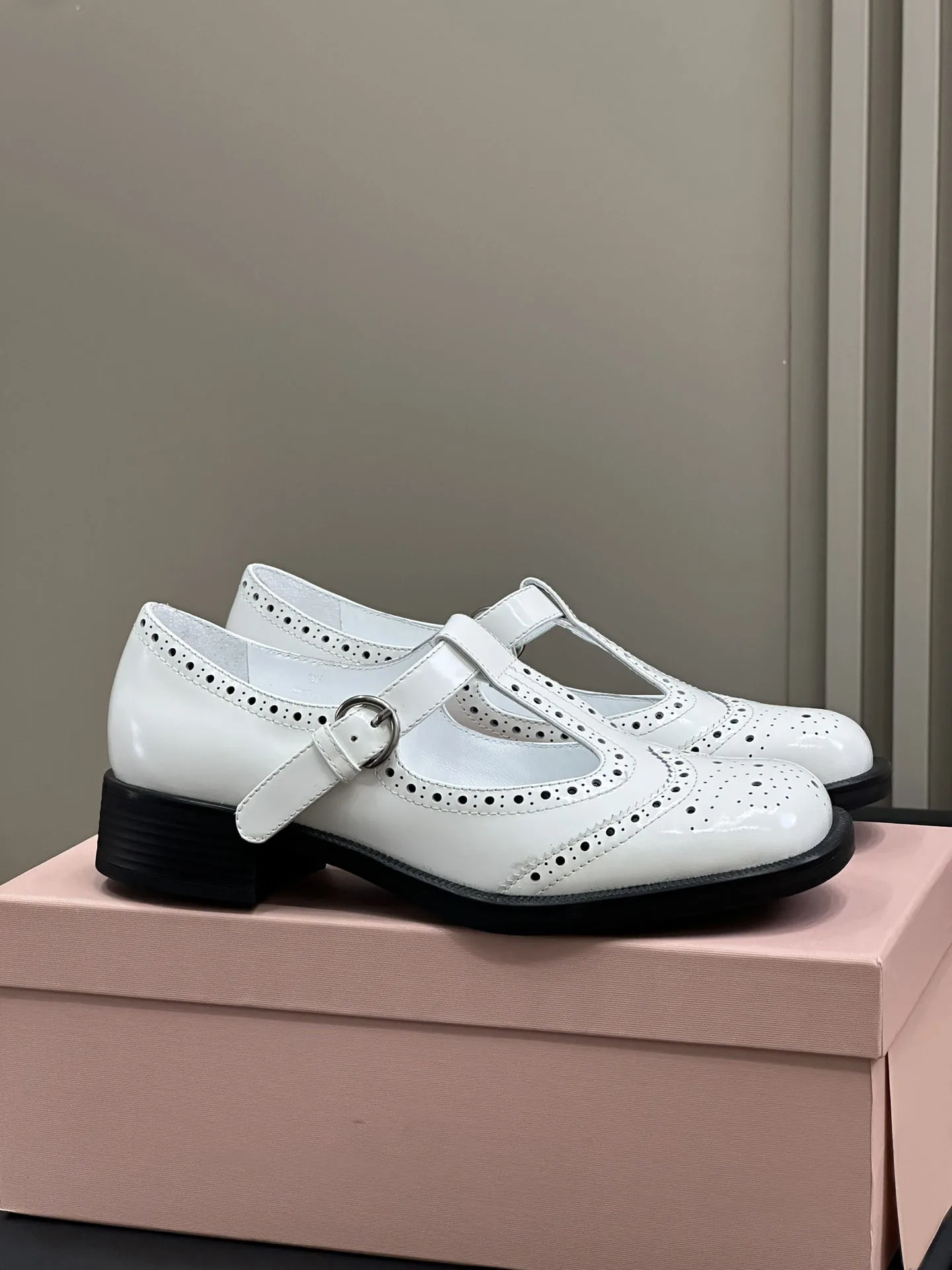
For those interested in comparing different professional footwear options, our guide to loafers versus heels as professional footwear examines the merits of each. Additionally, our collection of women’s heeled loafers showcases various heel styles that maintain comfort while offering different aesthetic options.
Are Wedge Heel Loafers Right for Everyone? Considerations and Alternatives
While wedge heel loafers offer numerous advantages, they may not be the optimal choice for every person or situation. Understanding both their benefits and limitations helps determine if they’re right for your specific needs.
Who benefits most from wedge loafers?
Wedge loafers are particularly beneficial for those who want height with stability, including people who find traditional heels uncomfortable or unstable. They’re excellent for individuals who stand or walk extensively throughout their day but need to maintain a polished, professional appearance. Those transitioning from exclusively wearing flats to incorporating some heel height often find wedges to be an approachable starting point.
Are there any foot types that should avoid wedge heels?
People with certain pronounced foot conditions like severe plantar fasciitis, Achilles tendonitis, or rigid high arches might need to approach wedges cautiously. While wedges are generally more foot-friendly than stilettos, they still alter your foot’s natural position. Those with significant foot pain or structural issues should consult a podiatrist before choosing any heeled footwear, even wedges.
What alternatives offer similar comfort with different aesthetics?
Block heel loafers provide another stable option with a different visual profile. Their chunky, separated heel offers good stability while creating a more defined silhouette than wedges. For those prioritizing maximum comfort, quality flat loafers with proper cushioning and arch support can provide all-day wearability without any heel height. Platform loafers offer height through an elevated sole while maintaining a flat foot position internally.
How should I care for my wedge loafers to maintain their comfort?
Regular maintenance helps preserve both the comfort and appearance of wedge loafers. Use appropriate cleaners and conditioners for the specific material of your shoes. Insert shoe trees or stuff with tissue paper when not wearing them to help maintain their shape. Address any wear to heels promptly, as uneven wear can affect your gait and comfort. Consider rotating between multiple pairs rather than wearing the same shoes daily, allowing them to fully dry and recover their cushioning between wearings.
For those seeking alternatives, our collection of women’s block heel loafers offers another comfortable option with a distinctive aesthetic approach.

